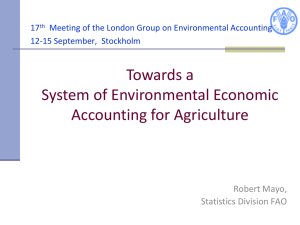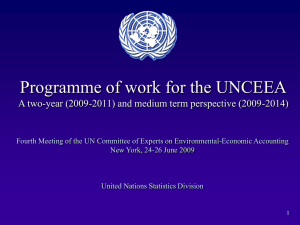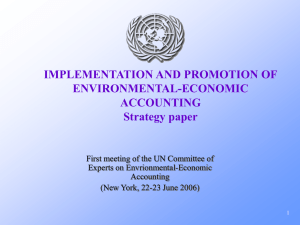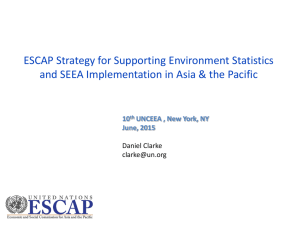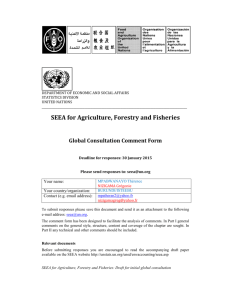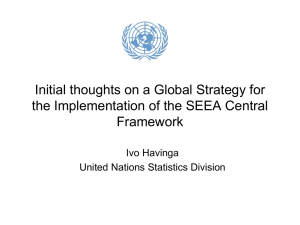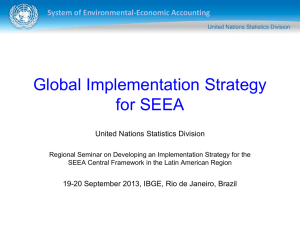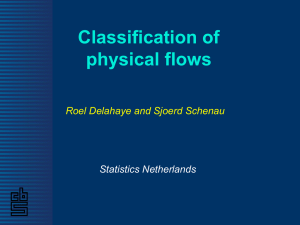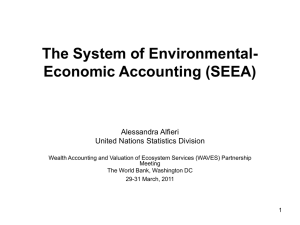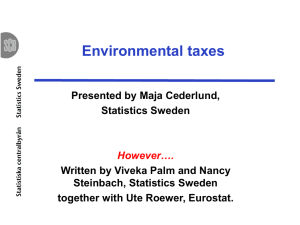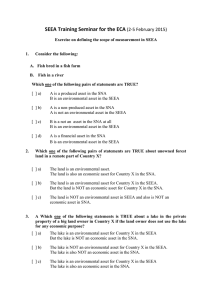Sixth Meeting of the United Nations Committee of Experts on
advertisement
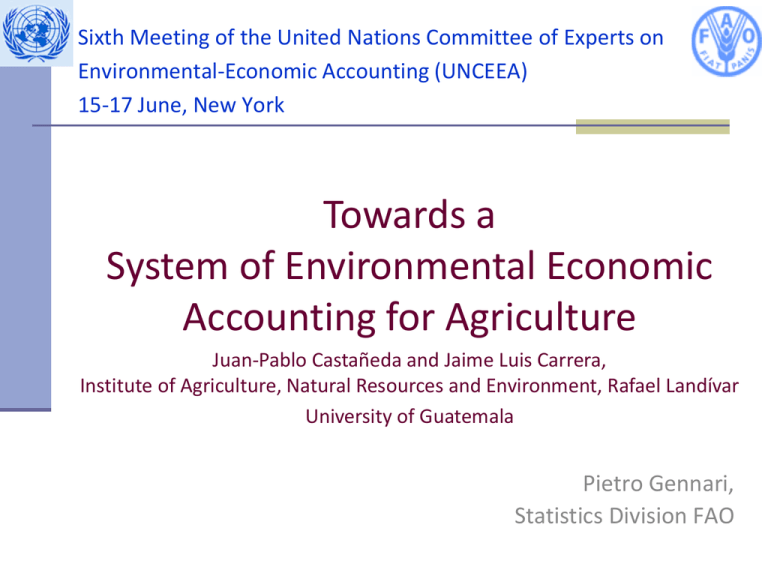
Sixth Meeting of the United Nations Committee of Experts on Environmental-Economic Accounting (UNCEEA) 15-17 June, New York Towards a System of Environmental Economic Accounting for Agriculture Juan-Pablo Castañeda and Jaime Luis Carrera, Institute of Agriculture, Natural Resources and Environment, Rafael Landívar University of Guatemala Pietro Gennari, Statistics Division FAO Content 1. The need of an accounting framework for 2. 3. 4. 5. agriculture and the environment Integrating agriculture activities in one framework Relationship with other accounting frameworks Implementation feasibility Proposed handbook development process Why a SEEA-Agriculture? • Policy and research needs - given the strong relationship between Agriculture and the environment major user of direct inputs from the environment; • major contributor to environment degradation; • major provider/user of ecosystem services • • Builds on existing accounting frameworks • SEAFA and EEA = extension to include sustainability of production, consumption and accumulation • SEEA-FO and SEEA-FI = extension to cover the whole Agricultural sector Why a SEEA-Agriculture? • Provides the conceptual framework for the Global Strategy to improve Agricultural and Rural statistics, (UNSC, Feb. 2010). • Foundation for integrating food and agricultural statistics into National Statistical System • establishing a core minimum set of statistical indicators • multidimensional information system that combines and harmonize data from various surveys and censuses What is SEEA-Agriculture? • Subsystem of the SEEA: Standard satellite account for the • • • • integration of agriculture and environmental data. Allow monitoring of the economic importance of agriculture; estimation of its full costs & benefits; improvement of its management; Life cycle analysis appr. Based upon internationally agreed concepts, definitions, classifications and inter-related tables and accounts Relevant for both developed and developing countries Different from other SEEA subsystem => focuses on one broad activity rather than on one specific resource Integrating agricultural activities • Definition of Agriculture in the ISIC rev. 4, includes 3 groups of activities: • Crop and animal production, hunting and related service activities • Forestry and logging • Fishing and aquaculture • Reasons for integration of these 3 groups of activities: • closely interconnected at the farm level (most farms are engaged in more that one of these activities at the same time); • same data source (common for agricultural surveys and censuses to include some information about all this group of activities). • All 3 sub-sectors strongly related to basic population needs of food, energy, shelter and other uses of raw materials. The SEEA-AGRI as SEEA subsystem SNA FAO agriculture and food accounting SEAFA SEEA EAA SEEA accounts Forest SUA Fishery Water Energy Land and ecosystems SEEA-AGRI SEEA-AGRI accounts • Asset accounts, in physical and monetary values, covering • • • • natural resources, land and ecosystems and their changes during the accounting period Flow accounts physical and hybrid supply and use tables covering flows of products, residuals, natural resources and ecosystem services Environmental protection accounts detailing the economic transactions of the public and private sector related to the environment costs and benefits of reducing human impact on the environment Adjusted macro indicators accounts: environmental adjusted SNA aggregates in the institutional sector accounts (eaNDP). Satellite accounts and supplementary tabulations relating to food and agriculture (including physical food balances) Feasibility of implementation • The flexibility of the system allows a modular and selective • • • • approach according to: Data availability; Data quality; Country agricultural structure 3 types of datasets: minimum requirement; recommended; desired Identification of a core account is critical for upscaling and implementation Technical capacity in countries needs to be strengthened (link to the implementation Plan of the Global Strategy) Synergies with the implementation of the SEEA SEEA-AGRI Development Process UNCEEA and the LG as forums for review and discussion towards development of SEEA-AGRI Establishing agro-environmental sub-group of the LG to address specific issues and develop compilation guidelines Proposed roadmap includes 5 stages in a 2(3) year process: Conceptualization (initial 6 months) Organization Consultation (throughout the project) Drafts and final document Pilot application and feedback (from 18 to 21) Work Plan Months Stage 1 2 3 A. Conceptualization Conceptual framework definition 4 5 6 7 8 9 10 11 12 13 14 15 16 17 18 19 20 21 22 23 24 Outline preparation B. Organization Assign duties Drafting and consultation management D. Consultation FAO internal discussions E. Drafts and final document F. Pilot application and feedback Applications and assessment Final drafting and reporting Discussion meetings with: FAO-ESS, UNCEEA, London Group Final draft preparation Final document and approval process Pilot applications in developing countries Framework limitations SOCIAL ASPECTS = limited development of specific interactions between the environmental and social dimensions TIME = agri-environmental issues are not subject to a year-based system (seasonal, ephemeral, etc) SPACE = Need of sub-national observations units to understand agri-environmental dynamics VALUATION = Agreed methodology on the valuation of ecosystem services used/delivered by agriculture
